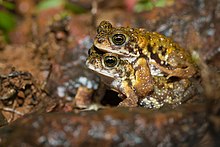Xanthophryne
Appearance
| Xanthophryne | |
|---|---|

| |
| Amboli tiger toads mating | |
| Scientific classification | |
| Domain: | Eukaryota |
| Kingdom: | Animalia |
| Phylum: | Chordata |
| Class: | Amphibia |
| Order: | Anura |
| Family: | Bufonidae |
| Genus: | Xanthophryne Biju, Van Bocxlaer, Giri, Loader, and Bossuyt, 2009[1] |
| Type species | |
| Bufo koynayensis Soman, 1963
| |
| Diversity | |
| 2 species (see text) | |
Xanthophryne is a small genus of toads in the Bufonidea family. They are endemic to the Western Ghats in Maharashtra, India.[2] Its sister taxon is Duttaphrynus. The name is derived from two Greek words, xanthos meaning yellow and phryne meaning toad.[1]
Description
Xanthophryne are relatively small toads: adult males measure 24–33 mm (0.94–1.30 in) in male snout–vent length and females 33–35 mm (1.3–1.4 in)). They have light brown dorsum with a suffusion of dull chrome-yellow; flanks and sides of the abdomen have chrome-yellow patches, sometimes a few continuous bands. Tympanum is indistinct. There is no webbing between the toes and fingers. Eggs are laid in clutches.[1]
Species
There are two species in this genus:[2][3]
- Xanthophryne koynayensis (Soman, 1963)
- Xanthophryne tigerina Biju, Van Bocxlaer, Giri, Loader, and Bossuyt, 2009
References
- ^ a b c Biju, S.D., Ines Van Bocxlaer, Varad B Giri, Simon P Loader and Franky Bossuyt (2009). "Two new endemic genera and a new species of toad (Anura: Bufonidae) from the Western Ghats of India". BMC Research Notes. 2: 241. doi:10.1186/1756-0500-2-241.
{{cite journal}}: CS1 maint: multiple names: authors list (link) CS1 maint: unflagged free DOI (link) - ^ a b Frost, Darrel R. (2014). "Xanthophryne Biju, Van Bocxlaer, Giri, Loader, and Bossuyt, 2009". Amphibian Species of the World: an Online Reference. Version 6.0. American Museum of Natural History. Retrieved 24 July 2014.
- ^ "Bufonidea". AmphibiaWeb: Information on amphibian biology and conservation. [web application]. Berkeley, California: AmphibiaWeb. 2014. Retrieved 24 July 2014.
External links
Wikimedia Commons has media related to Xanthophryne.
